#博物
Text













2024.06.30(日)
茅の輪をくぐり身を清め、今年もあと半分、家族共々無事にすごせるように祈願してきた。
その後福井駅前の「芝寿し」で「夏の野菜たっぷり弁当」を購入し、越前古窯���物館 旧水野家住宅へ出向いてお弁当を食し、陶ふうりんに癒されたそんな梅雨の一日。
193 notes
·
View notes
Text







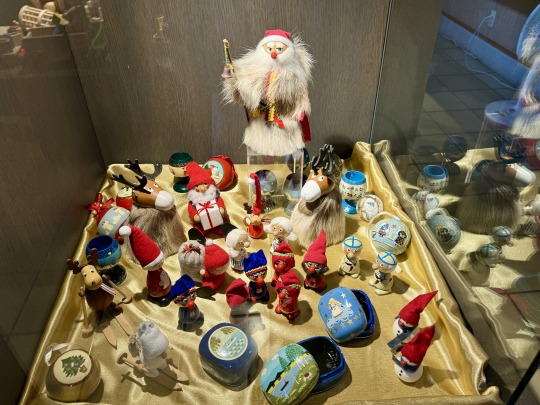




Karuizawa Erz Toy Museum
149 notes
·
View notes
Text
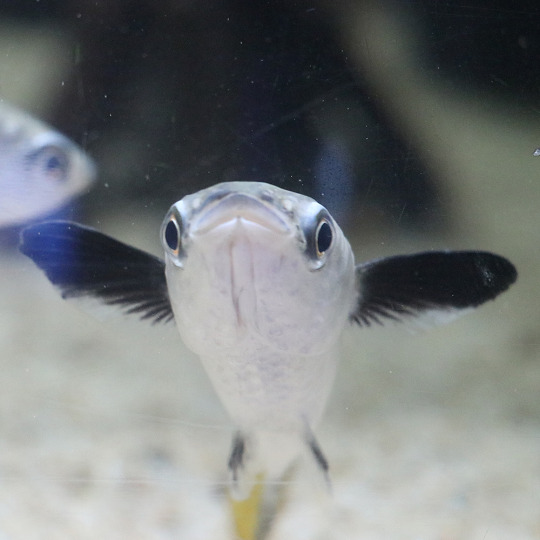
かわいすぎる
@東海大学海洋科学博物館
They are too cute.
@Marine Science Museum, TOKAI University
298 notes
·
View notes
Text
April 11, Xi'an, China, Xi'an City Museum/西安博物院 (Part 1):
Since I didn't take pictures of all the plaques, and some of these artifacts can be near impossible to look up, I will not attempt to name all of them.
The entrance to the Xi'an City Museum, also called 西安市博:
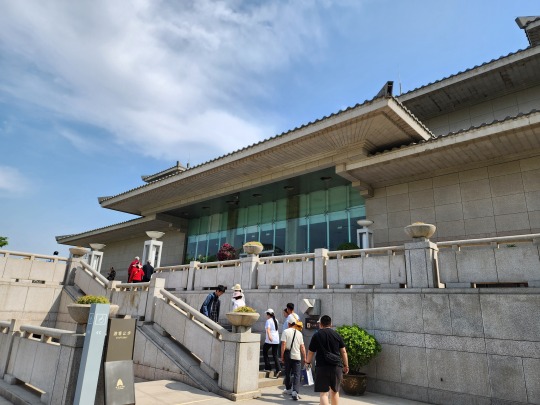
Xi'an city used to be called Chang'an/长安, and was the capital city of 13 different dynasties, including Qin dynasty, Han dynasty, and Tang dynasty. This is a (pretty big) model of Chang'an city in Tang dynasty, including parts of the palace:


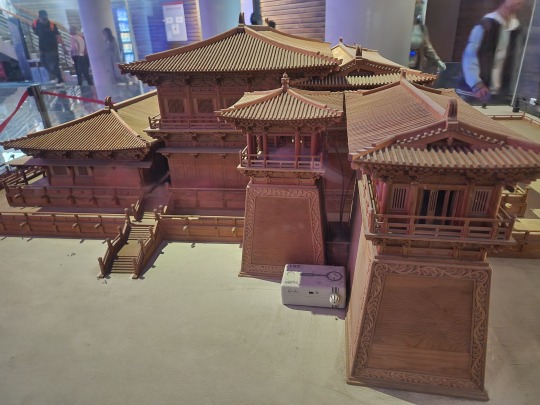
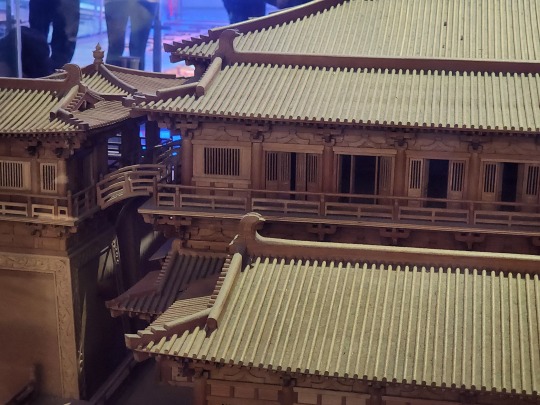
Various Buddhist statues from different dynasties:

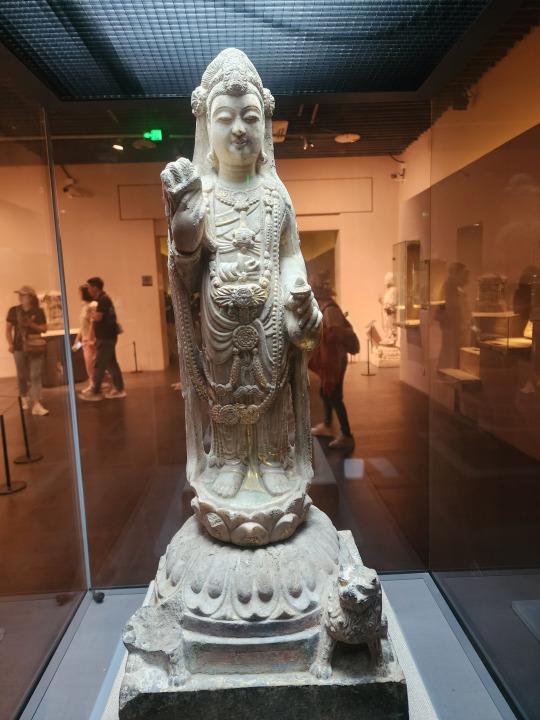

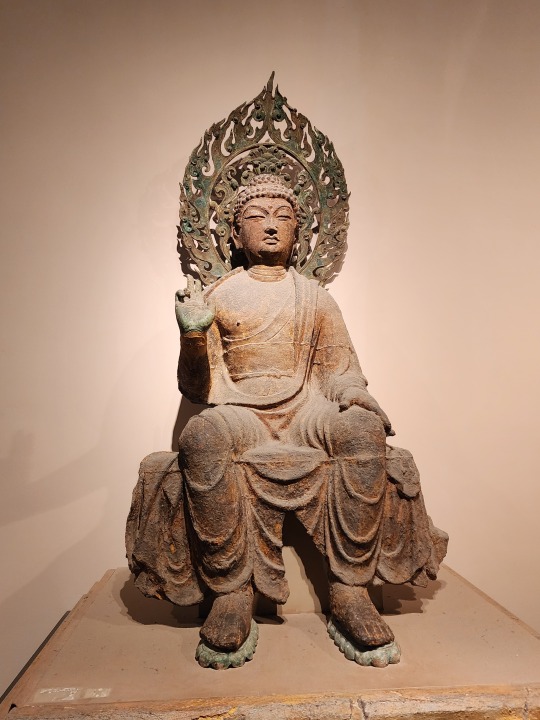
And a statue of Guanyin (Avalokiteśvara) that's in a pose I've never seen before:
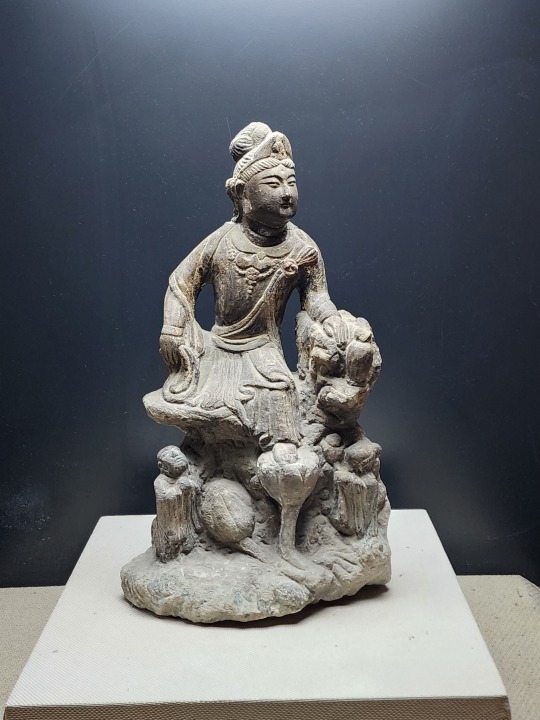
Stone column with a loong dragon and clouds carved upon it:
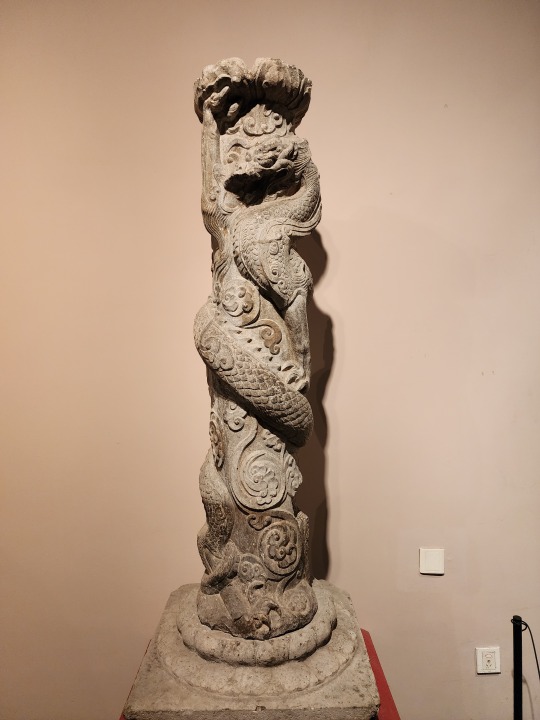
I didn't take a picture of the plaque, but if I remember right this is a bixi/笔洗, or a small bowl containing water where you rinse your brush, and in this case it's fashioned from jade:

A carved jade decor (from a belt?):
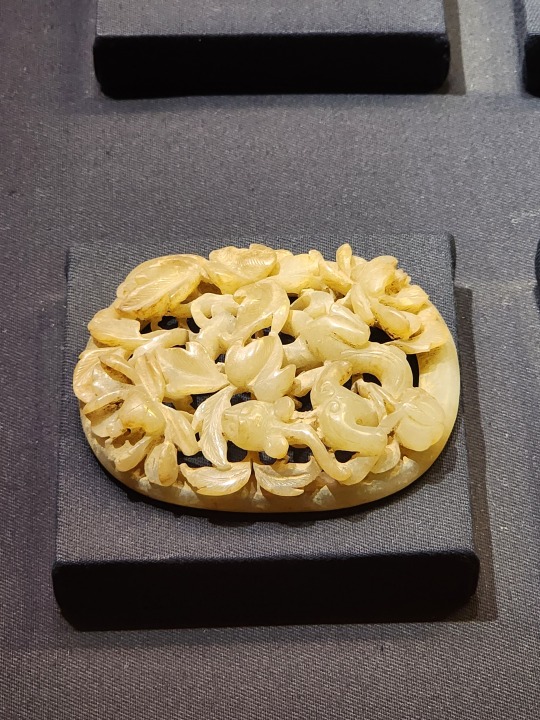
A Qing dynasty jade zhaijie/斋戒 tag. Zhaijie is usually translated as "fasting", but it's more than that, it combines temporary dietary restrictions (definitely no meat or fish/seafood or alcohol, I'm not sure about animal products) and abstinence from a variety of activities, like enjoying feasts, entertainment, and working on official business. Those in mourning may be exempt from zhaijie. This tag was worn by officials when there were major national ceremonies going on, for example the annual ceremonies at Temple of Heaven/Tiantan/天坛 where the emperor prays for rain and a good harvest, as a reminder to observe the zhaijie rules during the ceremony:
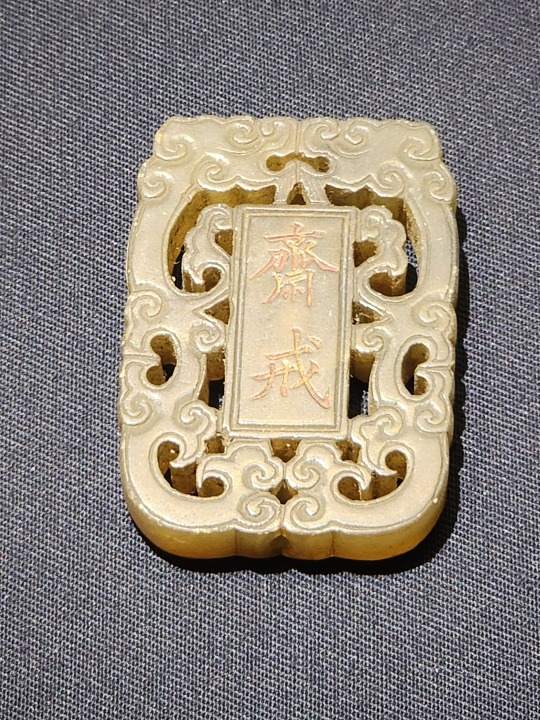
Painting from Republic era (1946). I can literally read everything on the upper left but the name of the painter.........................sigh. Can't find it online either. Anyway I love how the painter created depth here:
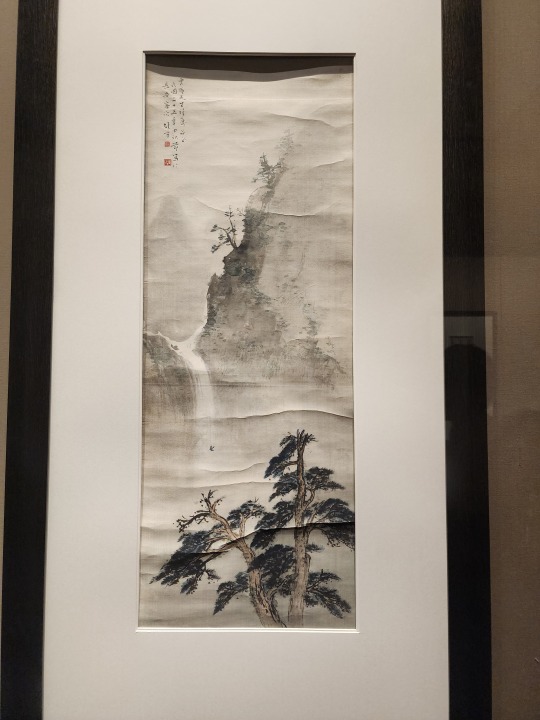
This painting is by Qing era painter Zhang Qia/张洽 in 1787. I love the brushwork:
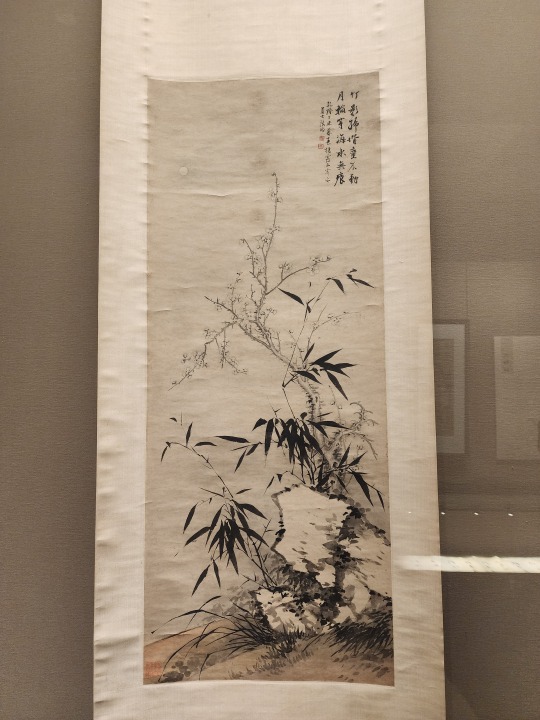
Totally forgot to take a picture of the plaque, but I love this calligraphy:
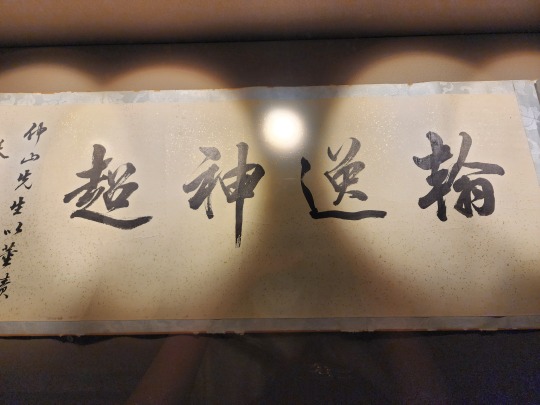
Bronze ritual wine vessel (called hé/盉) with phoenix head spout, from Warring States period (475 - 221 BC):
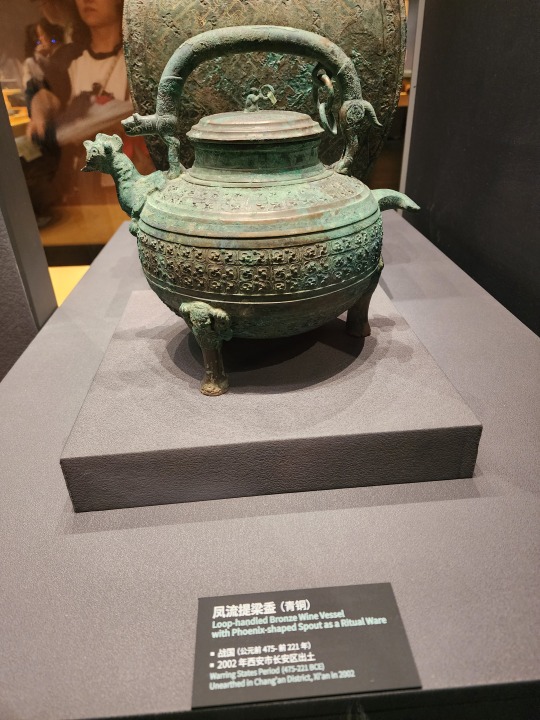
Bronze wine vessel (called jué/爵), if I remember right, this is from Zhou dynasty (1046 - 256 BC):
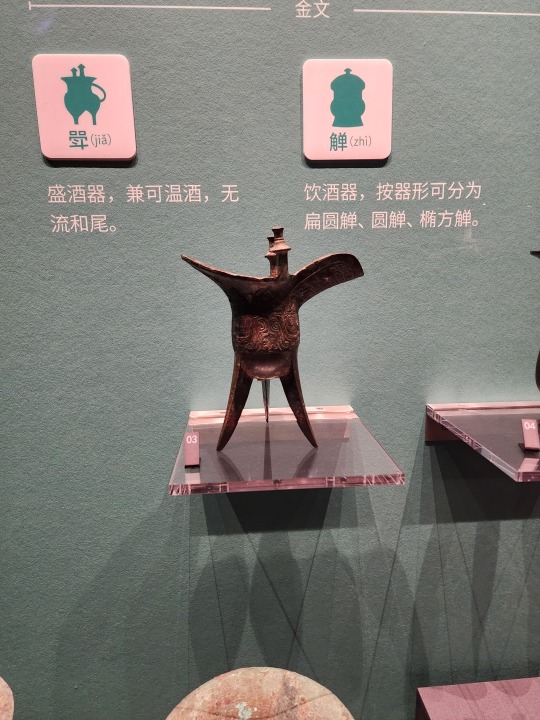
Bronze bells, part of a bianzhong/编钟 set. Although pentatonic scale has been seen as a key characteristic of traditional Chinese music, the bianzhong can play in heptatonic scale. And for the physics lovers out there, this kind of bell is very interesting in that the cross section is almond-shaped, and a single bell can produce two different tones depending on where it is struck. The protrusions on the bell (called mei/枚 or zhongru/钟乳) apparently affect the frequency of the sound produced as well.
The Bianzhong of Marquis Yi of Zeng (曾侯乙编钟) is the oldest playable set that has been found so far, discovered in the tomb of Marquis Yi of Zeng (died 430 BC). A full album was recorded with this ancient bianzhong set in 1989.
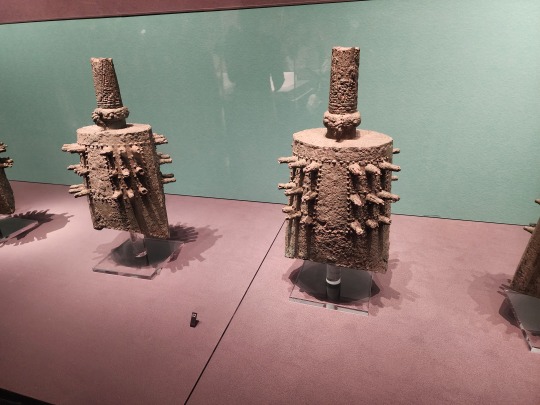
Early currency....yep these are shells. This is the reason why Chinese characters with the shell radical (贝/貝) usually have to do with money or treasure (ex: 财, 寶, 购, 赎, etc etc):
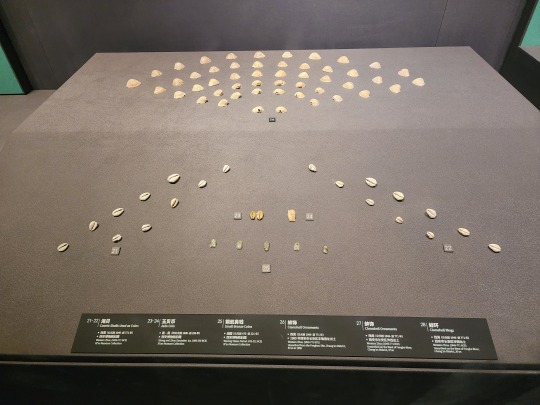
Different coins from different states in the Warring States period:
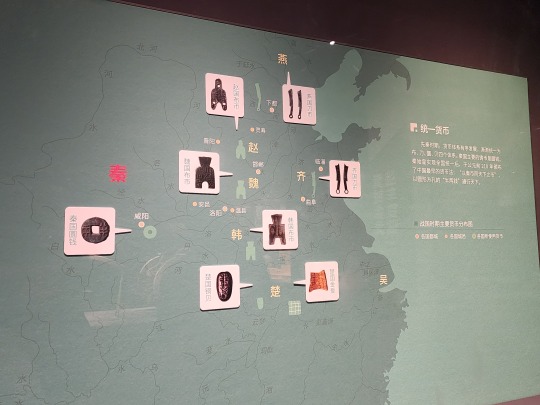
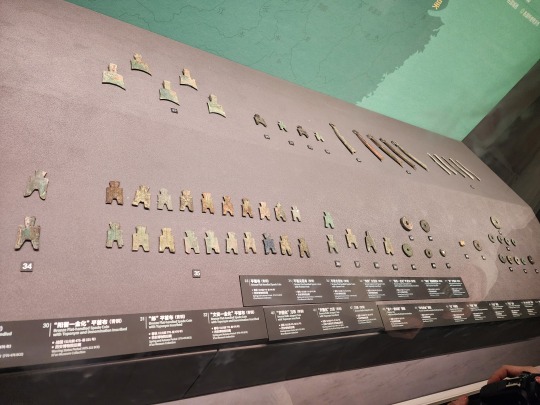
Different coins and molds after Qin dynasty (the weirdly shaped ones are apparently all from Xin dynasty/新莽):

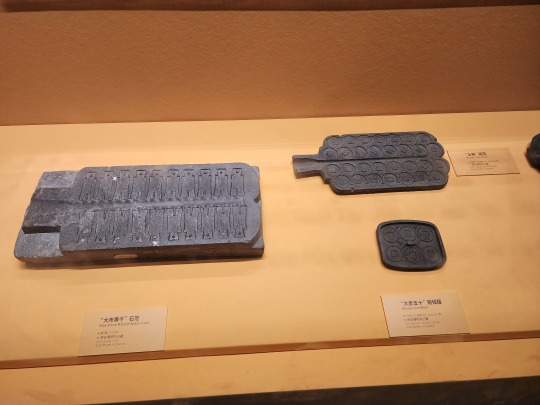
Different seal stamps. I love the one with the turtle on it
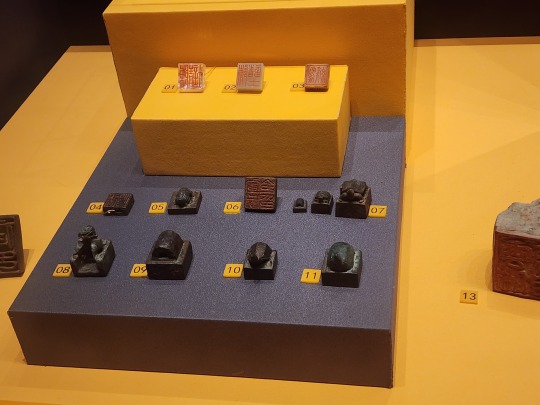
#2024 china#xi'an#xi'an museum#西安博物院#chinese history#chinese art#chinese painting#chinese calligraphy#chang'an#history#art#calligraphy#china#edited since the bell physics article link keeps dying....hopefully I've fixed it for good
99 notes
·
View notes
Text

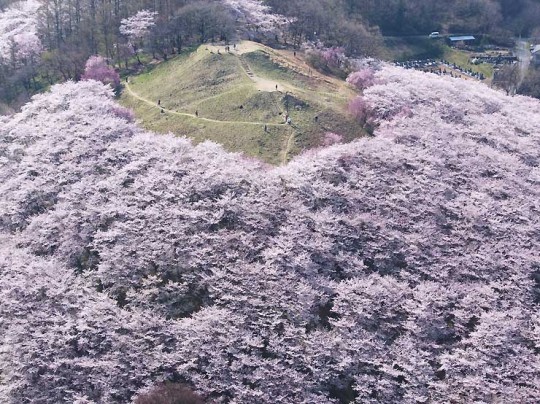


考古学ジャポニストは、長野県のさまざまな古墳を見ることができる一連の日本の原史時代に歓迎されています。 古墳はすべて松本市にありますので、安心して始めましょう。
-
私が最初に紹介する墓は高望山と呼ばれていますが、どの時期に建てられたのですか? 誰が埋葬されたのですか?古墳は西暦3世紀から4世紀にまでさかのぼります。古墳の大きさは66メートルで、1974年に考古学調査が行われました。
-
彼は現在、いくつかの考古学的発掘調査の真っ最中です。ニュースを知ったら、それをお届けします。 現時点では、誰が埋葬されたかは不明です。
よろしくお願いします。次の章でお会いしましょう。
-
心からのご挨拶と、よろしければ読んでいただきありがとうございます。コメントして共有し、より多くの人が日本の小さな作品を手に入れられるようにしてください。
-
Archaeological Japonists are welcome to a series of Japanese protohistory, in which we will see different burial mounds of the Nagano prefecture. All the burial mounds are located in the city of Matsumoto, with that being said, make yourself comfortable, let's begin.
-
The first tomb that I present to you is called Koboyama. In what period was it built? Who was buried in it? The burial mound dates back to the 3rd and 4th centuries AD. The dimensions of said burial mound are 66 meters and in the 1974 decade archaeological studies were carried out.
-
He is currently in the middle of some archaeological excavations, when I know any news I will bring it to you. At the moment it is not known who was buried.
I hope you like it and see you in the next chapter.
-
Cordial greetings and thanks for reading it if you liked it, comment and share so that more people take a little piece of Japan.
#考古学博物館#松本市#長野県#日本#なみやなぎ#先史時代の日本#日本の原史時代#遺跡#ユネスコ#弘法山#地理#工房山工房#古墳時代#設楽町#内貝津橋遺跡#発掘調査#愛知埋文#考古学#安城市#宮下南遺跡#発掘#NaganoPrefecture#Japan#PrehistoricJapan#ProtohistoryofJapan#Koboyama#Geography#MontainKobo#Kofunperiod
54 notes
·
View notes
Text
#@Akai_kiir0#Amano Game Museum#天野ゲーム博物館#arcade#game center#arcade gaming#candy cabinet#candy cab#arcade machine#arcade cabinet#video games#retro gaming#arcade cocktail#vending machine#video
32 notes
·
View notes
Text

夏旅2024 新潟散策 - マリンピア日本海+うみがたり
旅に水族館撮影は欠かせない(?)ということで日本海側の2つの水族館 新潟市水族館マリンピア日本海と上越市立水族博物館うみがたりをはしごしてみた。
新潟市水族館 マリンピア日本海
本州 日本海側最大規模の水族館、マリンピア日本海。新潟駅から比較的運行本数の多いバス 1本で到着。アクセスの良さはありがたい。朝一でも入場券売り場には列が。。。それを見越して前日 コンビニで前売り券を購入していたため、列をスルーして入館。前日の自分に感謝。


入ってすぐ、浅瀬や干潟が再現された潮風の風景から始まり、波立つ日本海を再現した大水槽、暖かい海域のエリア、信濃川の清流ゾーン等、見所いっぱい。もちろんクラゲも激写。


屋外ではアシカやアザラシ、トドのコーナーへ。海面から顔を出してぷかぷか浮かぶ姿がかわいくて、ずっと見て飽きが来ませんね。
(1枚目のアイキャッチ画像もマリンピア日本海にて)
上越市立水族博物館 うみがたり


直江津駅から歩くこと15分弱の上越市立水族博物館 うみがたりへ。朝一 高田の蓮へ寄り道して出遅れた、+夏休み真っただ中で、「すみっコぐらし」とのコラボ展示の影響もあるのか(?)、なかなかの混雑具合。。。こちらも前売り券を事前手配していたからよかったものの、入場券の窓口は炎天下の中 長蛇の列となっていました、お疲れ様です。。。


こちらの水族館はマゼランペンギンの飼育数が世界一で知られているとのこと。ちょうど到着したタイミングはペンギンさんのお食事タイム、ということでまだかまだかと順番待ちするペンギンさんの様子を撮影してみた。


日本海、上越エリアの豊かな自然の中で育まれる生命の美しさを堪能できました、満足。
24 notes
·
View notes
Video
undefined
tumblr
“ The Tsubame SL Steam Locomotive “ // © arisachw
Catching the Tsubame SL Steam Locomotive in action. This locomotive runs once every hour on a daily basis* for 1km (round trip) and can be spotted from Umekoji park.
Tsubame means Swallow in Japanese, can you spot the bird logo on the locomotive?
Visitors of the railway museum can ride this train for an additional fee of 300 yen (adults) /100yen (kids).
Music: Han Seung Wook - Spring is Coming
#京都鉄道博物館#Kyoto Railway Museum#Kyoto Prefecture#Japan#cityscape#landscape#spring#railway#locomotive#Sakura#cherry blossom#4K#8K#fpv#reels#aesthetics#wanderlust#explore#follow#discover
324 notes
·
View notes
Photo
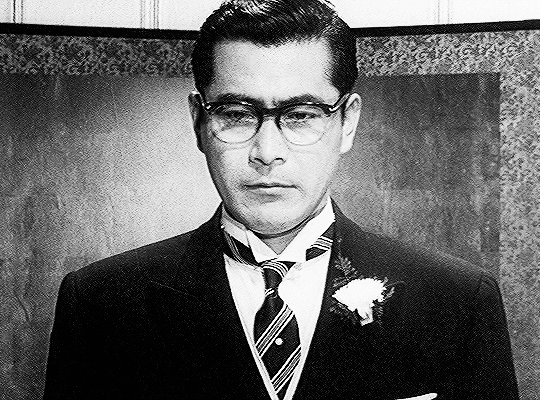

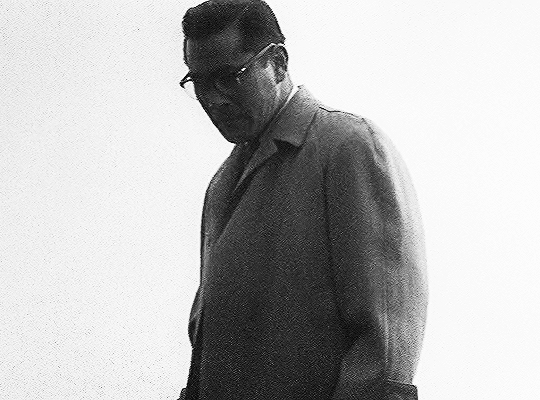


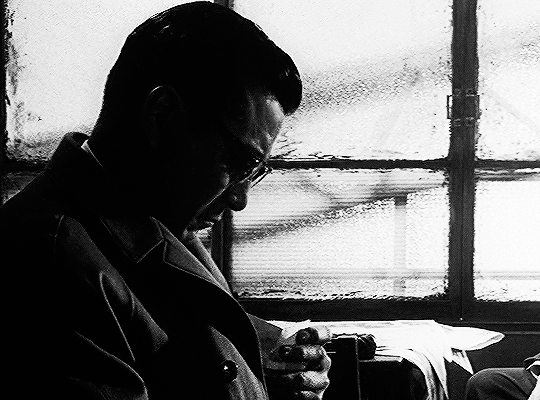




三船敏郎 | 悪い奴ほどよく眠る (1960, 黒沢明)
#不打偷图狗死全家的tag不行是吧#那就打咯#偷图狗死全家#就你有手 就你有微博#长了手不学好的废物 只会右键窃取别人的劳动成果自己赚流量啦#toshiro mifune#三船敏郎#the bad sleep well#classicfilmsource#mine#悪い奴ほどよく眠る#akira kurosawa#黑沢 明#look a mifune thats not a samurai! <3#and with glasses#this film is so underrated tbh#smoke tw#here am I queue me
390 notes
·
View notes
Text

千葉県立中央博物館にきました。




発掘された日本列島展を見学。今年は開催30年記念。

お昼は千葉市中央区の味楽園でタンメン。いかにも町中華という感じ。懐かしさすらありました。
23 notes
·
View notes
Text


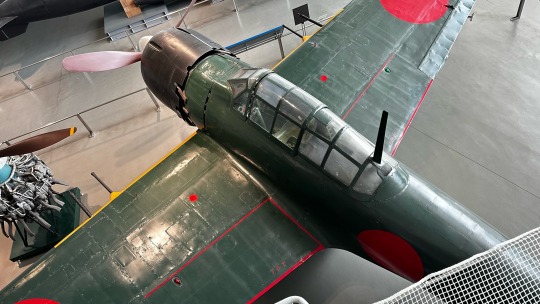

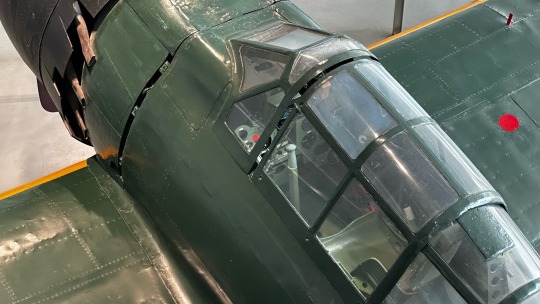
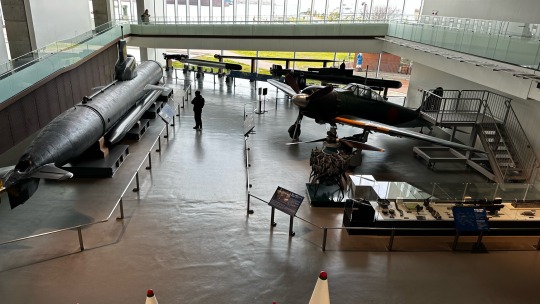


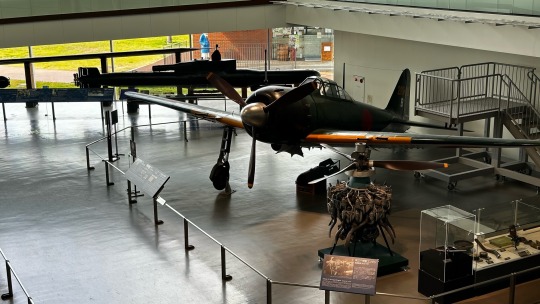
零戦
@大和ミュージアム
38 notes
·
View notes
Text
47 notes
·
View notes
Text

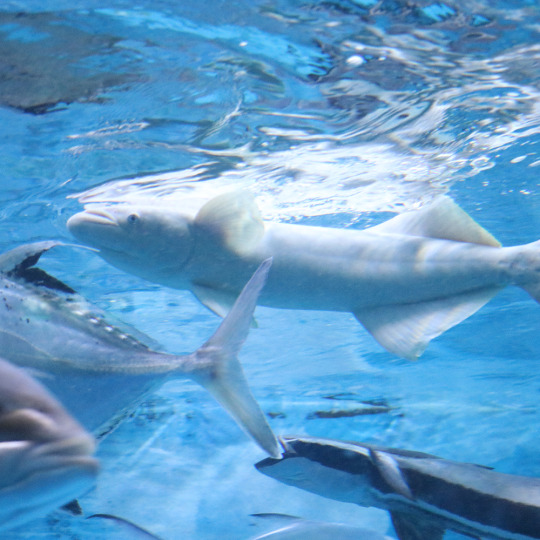


真っ白なコバンザメがいた。目は黒いのでリューシスティックでいいんでしょうか。
@東海大学海洋科学博物館
There was an all-white sharksucker. I think it might be leucistic because its eyes are black.
@Marine Science Museum, TOKAI University

ふつうのカラーリングの子。
He has a normal coloration.
291 notes
·
View notes
Text
April 11, Xi'an, China, Xi'an Museum/西安博物院 (Part 2):
First up, the star of the museum, Tang dynasty (618 - 907 AD) sancai/唐三彩 pottery figurine of a rider on a horse (三彩腾空马):


More Tang-era sancai pottery horse figurines:



This one is a sancai figurine of a camel......screaming? That's a reaction pic worthy face right there:

Another reaction pic worthy face.....this time on a small gold tiger figurine (the head looks more like a bat tbh lol):


Qin dynasty (221 - 207 BC) kneeling clay figurine. This is how people sat before raised seats and chairs became a thing, and this position is called jizuo/跽坐:

Bronze parts from a horse chariot (because the chariots were wooden, it decayed, leaving behind these bronze parts):

Left: bronze crossbow (called nu/弩) trigger mechanism and arrow heads (may be from Warring States period, 403 - 221 BC)
Right: Bronze swords and daggers. If I remember right, the ones on the bottom left are yue/钺 heads


Qin dynasty (221 - 207 BC) and Han dynasty (202 BC - 220 AD) wadang/瓦当, featuring various auspicious motifs and phrases. These are part of the roof edge in traditional Chinese architecture, as shown in the diagram on the right (wadang is on the bottom left in the diagram). Honestly I think at least some of these wadang designs can be used on mooncake moulds:


A golden loong dragon, very fitting for the Year of the Dragon 🐉:

A (giant) pottery brick decorated with two loong dragons:

A pottery lantern, I believe this is specifically made to be buried in a tomb

Green-glazed pottery dog from Han dynasty (202 BC - 220 AD). It's speculated that this actually depicts a songshi/松狮 dog, which was the breed that the chow chow was developed from. Note the wide head, small upright ears, sturdy protruding snout, stocky build, and the tail curved onto its back. This breed can still be found in China today:

Left: pottery female figurines, probably from Wei, Jin, Southern and Northern dynasties/魏晋南北朝 (220 - 589 AD), since this cross-shaped hairstyle/十字髻 was one of the characteric hairstyles of that time period.
Right: pottery female entertainer figurines, judging by the hairstyles, these are probably from Tang dynasty (618 - 907 AD). The hairstyle of the musicians to the sides are banfanji/半翻髻, the musician to the left is playing a sheng/笙, while the musician to the right is playing a paixiao/排箫. The dancer in the middle has a feixianji/飞仙髻 hairstyle.


Tang-era bronze mirror decorated with auspicious creatures and grapes. Traditionally, grapes motif symbolize longevity and wealth. This is the back of the mirror, the other side is the actual mirror, which is polished frequently and meticulously so that it may serve its purpose.

Various Tang-era hair ornaments made of silver, gold, or jade:

Tang-era sancai pottery tomb guardians:

Northern Zhou-era (557 - 581 AD) stone sarcophagus from Tomb of Master Shi/史君墓, also known as Tomb of Wirkak, dating from 580 AD:

A close up at the epitaph on the sarcophagus, which is written in Chinese and Sogdian. Translation of the epitaph from Wikipedia:
(The period) Daxiang of Great Zhou, year 2, in the first month of a rat year, on the 23rd day. So: there was a man of a family from Kish, domiciled in Guzang. From the emperor he holds the rank (of) sabao of Guzang, in the land of the Sogdians, a landowner. He is named Wirkakk, the son of Wanuk, (namely) Wanuk, the son of the sabao. And (his) wife, born in Xinping, is named Wiyusi. And Wirkakk the sabao married (his) wife in Xinping in a pig year, on the 7th day of the 6th month, on a hare day. And afterwards, here in Xianyang (= Chang’an), he himself died in a pig year, on the 7th day of the 5th month. And his wife too died on the 7th day of the 6th month, on a hare day, in the same year (as her) marriage, the same month, the same day. There is no living being which is born which is not subject to death; moreover, it is hard to complete (one’s) period in the world of the living. But this is harder (still), that, without being aware (of it), a husband and wife see one another (for the first time) the same year, the same month, the same day, in the human world (and) also in paradise, (so that) the beginning of (their) life together (in each place) may be at the same period. This stone tomb was made by Vreshman-vande, Zhimat-vande (and) Prot-vande, desiring a suitable place for (their) father (and) mother.
— Epitaph of the tomb of Wirkak. Translated from the Sogdian by Nicholas Sims-Williams.

A clay model of a building for burial, if I remember right this is from Ming dynasty (1368 - 1644), I'm not 100% sure.
Traditionally, Chinese people believe that spirits of the dead will continue to exist and "live", so the dead must be treated as if they are alive, a concept known as 事死如事生. This is why ancient Chinese tombs were often filled with belongings of the deceased, their favorite and most prized treasures, and (often clay) models of houses and possessions, etc. A very famous example of this is Qin Shi Huang's terra cotta army. This is also why Chinese people today still burn paper offerings in the shape of money (mingbi/冥币; colloquially called paper money/纸钱) and items (called zhizha/纸扎) for the deceased. The biggest difference is that today's paper offerings might take the shape of modern items like laptops or cars.

Ming-era pottery figurines, arranged in a procession

A landscape painting hand scroll, and if I'm reading the plaque right (there were a lot of people so I didn't get to take a picture of the plaque), it's by famous Yuan dynasty painter Zhao Mengfu/赵孟頫 (1254 - 1322). This particular style of landscape painting is called blue-green landscape painting (青绿山水画), and is so named for its characteristic blue-green color of the mountains. Since the color was produced by mineral pigments, it's long-lasting and does not fade. The most famous painting of this style is One Thousand Li of Rivers and Mountains (《千里江山图》) by Wang Ximeng/王希孟 in Northern Song dynasty (960 - 1127 AD).

And last but not least, this one surprised me too......clay water pipes from Qin dynasty (221 - 207 BC):

#2024 china#xi'an#china#chinese history#chinese art#chinese painting#history#art#archaeology#xi'an museum#西安博物院
80 notes
·
View notes
Text

Capítulo 2: El camino hacia el enigma
-
Sean bienvenidos, japonistasarqueológicos, al siguiente capítulo de las ruinas Weda en el capítulo anterior estuvimos hablando de donde se localiza el asentamiento, cuáles son los ríos que lo rodean el emplazamiento, de cuando data el mismo y cuando se empezó a cultivarse el arroz. También comentamos que había misterios desde los periodos Yayoi tardío al Kofun, ya que había pocos asentamientos continuos, pero sí que hay del periodo Heian.
-
La primera prospección fue llevada a cabo en 2013, dichos resultados no arrojaron luz suficiente a los restos para una mayor comprensión del asunto expuesto. Habría que esperar a la segunda para qué arroja nuevas esperanzas, la cual se descubrieron restos de viviendas en foso del siglo IX d.c¿Qué se encontraron? Los restos que salieron fueron los siguientes: Un horno de herrería, con una estufa de cocina, ambos restos arqueológicos fueron tanto como un taller y una residencia.
-
También se encontró una fosa con una zanja que rodeaba el asentamiento, se ha excavado un producto de cobre con forma de pájaro la fecha y el propósito de su elaboración no está resuelto, todavía esperemos que próximos estudios arrojen luz a los restos y al yacimiento.
-
Espero que os haya gustado y nos vemos en próximas publicaciones de arqueología e historia de Japón.
-
第2章:謎への道
-
日本の考古学者の皆さん、ウェダ遺跡の次の章へようこそ. 前の章では、集落がどこにあ��のか、その場所を囲む川は何か、稲作が始まったのはいつから、いつ始まったのかについて話しました.弥生時代後期から古墳時代にかけての謎もあり、連続した集落は少ないが、平安時代のものはある。
-
最初の調査は 2013 年に実施されましたが、これらの結果は、露出した物質をよりよく理解するのに十分な光を遺物に当てはめませんでした。新たな希望を与えてくれる第二の発見を待つ必要があり、西暦 9 世紀の堀の住居跡が発見されました。出てきた遺跡は次のとおりです。 鍛冶屋のオーブン、キッチンストーブ、両方の考古学的遺跡はワークショップと住居の両方でした.
-
集落を取り囲む溝付きの穴も発見され、鳥の形をした銅製品が発掘されましたが、その精緻化の年代と目的は解決されていません。とサイト。
-
あなたがそれを気に入ってくれて、日本の考古学と歴史の将来の出版物でお会いできることを願っています.
-
Chapter 2: The path to the enigma - Welcome, Japanesearchaeologicalists, to the next chapter on the Weda ruins. In the previous chapter we were talking about where the settlement is located, what are the rivers that surround the site, when it dates back and when rice began to be cultivated. We also commented that there were mysteries from the late Yayoi to the Kofun periods, since there were few continuous settlements, but there are from the Heian period. -
The first survey was carried out in 2013, these results did not shed enough light on the remains for a greater understanding of the matter exposed. We would have to wait for the second one to shed new hope, in which remains of moat dwellings from the 9th century AD were discovered. What were they found? The remains that emerged were the following: A blacksmith's oven, with a kitchen stove, both archaeological remains were both a workshop and a residence.
-
A grave with a ditch that surrounded the settlement was also found, a copper product in the shape of a bird has been excavated, the date and purpose of its production is not resolved, we still hope that future studies will shed light on the remains and the site.
-
I hope you liked it and see you in future publications on archeology and history of Japan.
ソース写真/source photo:https://naganomaibun.or.jp/research/east/和田遺跡・和田1号塚/
#日本#考古学者#考古学#ユネスコ#日本の歴史#日本原史#古代世界日本#遺跡#考古学調査#和田遺跡#長野県#梓川#鎖川#稲作#故弥生#後期古墳プレードド#昭和だった#明治時代#住居跡と工房#鳥の形をした銅製品。#太子堂#マルヒロ#考古学博物館#Japan#archaeologist#archaeology#unesco#NaganoPrefecture#Azusariver
36 notes
·
View notes
